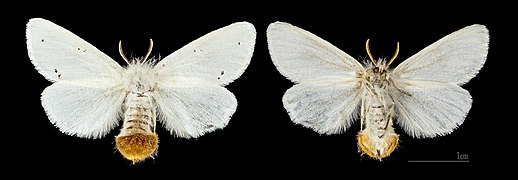Euproctis chrysorrhoea

| Mariposa lagarta cola parda | ||
|---|---|---|
 Mariposa lagarta cola parda | ||
| Taxonomía | ||
| Reino: | Animalia | |
| Filo: | Arthropoda | |
| Clase: | Insecta | |
| Orden: | Lepidoptera | |
| Familia: | Erebidae | |
| Género: | Euproctis | |
| Especie: | E. chrysorrhoea (Linnaeus, 1758) | |

La mariposa lagarta cola parda (Euproctis chrysorrhoea) es una polilla de la familia Erebidae. Se encuentra en Europa. En América del Norte solo se encuentra en la costa de Maine y Cape Cod donde está considerada una especie invasora que llegó a Estados Unidos en 1890 en plantas provenientes de Europa.[1]
Plantas de las que se alimenta
[editar]- Acacia
- Acer - Arce
- Arbutus
- Amelanchier
- Arctium
- Betula - Abedul
- Carya
- Castanea - Castaño
- Chaenomeles speciosa - Membrillo de flor
- Crataegus
- Cydonia - Membrillo
- Fagus - Hayas
- Forsythia
- Fragaria - Frutilla
- Fraxinus - Fresno
- Geranium
- Gossypium
- Hippophae
- Juglans - Nuez
- Malus - Manzano
- Myrica
- Parthenocissus
- Plantago
- Populus - Álamo
- Prunus
- Pyrus - Pera
- Quercus - Roble
- Rheum - Ruibarbo
- Ribes
- Robinia
- Rosa - Rosa
- Rubus
- Rumex
- Salix - Sauce
- Sambucus
- Sorbus
- Spiraea
- Tilia
- Trifolium - Trébol
- Ulmus - Olmo
- Viburnum
- Vitis - Uva
- Weigela
- Wisteria
- ♀
- ♂
Referencias
[editar]- Chinery, Michael Collins Guide to the Insects of Britain and Western Europe 1986 (Reprinted 1991)
- Skinner, Bernard Colour Identification Guide to Moths of the British Isles 1984
- ↑ Fernald, Charles H. & Kirkland, Archie H. (1903). "The brown-tail moth, Euproctis chrysorrhoea (L.). A report on the life history and habits of the imported brown-tail moth, together with a description of the remedies best suited for destroying it". Wright & Potter Printing Co., Boston.
- Jaenike, J. (1990) Host specialization in phytophagous insects. Annual Review of Ecology and Systematics, 21, 243-273.
- Forestry Compendium (2005) Euproctis chrysorrhoea L. (Lepidoptera: Lymantriidae) Datasheet. [Online] Wallingford: CAB International.
- Fernald,C. & Kirkland,A. (1903) The Brown-tail moth, Euproctis chrysorrhoea: a report on the life history and habits of the imported Brown-tail moth. Wright and Potter Printing, Boston.
- Saccuman, G. (1963) Contributo alla conoscenza della Euproctis chrysorrhoea L. Bolletino del Laboratorio di Entomologia Agraria "Filippo Silvestri", 21, 271-322.
- Torossian, C., Torossian, F., Roques, L. (1988) Le bombyx cul brun: Euproctis chrysorrhoea, (1) Cycle biologique-ecologie-nuisibilite. Bulletin de la Societe d'Histoire Naturelle de Toulouse 124, 127-174.
- Kelly, P.M., Speight, M.R. & Entwistle, P.F. (1989) Mass production and purification of Euproctis chrysorrhoea (L) Nuclear Polyhedrosis Virus. Journal of Virological Methods, 25, 93-99.
- Frago,E., Selfa,J., Pujade-Villar,J., Guara,M. & Bauce,E. (2009) Age and size thresholds for pupation and developmental polymorphism in the browntail moth, Euproctis chrysorrhoea (Lepidoptera: Lymantriidae), under conditions that either emulate diapause or prevent it. Journal of Insect Physiology, 55, 952-958.
- Dissescu,G. (1964) On a new method of the forecast of the Brown-Tail Moth. Zoologichesky Zhurnal, 43, 1795-1799.
- Schaefer,P.W. (1974) Population ecology of the browntail moth, Euproctis chrysorrhoea (Lepidoptera: Lymantriidae). PhD thesis. University of Maine, Orono.
- Zeitgamel, Y.S. (1974) Population dynamics of Euproctis chrysorrhoea in the Central-Chernozem State Reservation. Zoologichesky Zhurnal, 53, 292-296.
- Sterling,P.H. & Speight,M.R. (1989) Comparative mortalities of the Brown-tail moth, Euproctis chrysorrhoea (L) (Lepidoptera, Lymantriidae), in Southeast England. Botanical Journal of the Linnean Society, 101, 69-78.
- Arévalo-Durup, P. (1991) Le nid d'hiver d'Euproctis chrysorrhoea L. (Lepidoptera: Lymantriidae) comme estimateur de population en milieu forestier. Ph.D. Toulouse: Université Paul Sabatier.
- Elkinton, J.S., Preisser, E., Boettner, G. & Parry, D. (2008) Factors influencing larval survival of the invasive Browntail Moth (Lepidoptera: Lymantriidae) in relict North American populations. Environmental Entomology, 37, 1429-1437.
- Frago, E., Pujade-Villar, J., Guara, M., Selfa, J. (2011) Providing insights into browntail moth local outbreaks by combining life table data and semi-parametric statistics. Ecological Entomology 36, 188-199.
- Elkinton, J.S., Parry, D., Boettner, G.H. (2006) Implicating an introduced generalist parasitoid in the invasive browntail moth's enigmatic demise. Ecology 87, 2664-2672.
- Pantyukhov,G.A. (1962) The effect of positive temperatures upon different populations of the brown-tail moth Euproctis chrysorrhoea L. and the gipsy moth Lymantria dispar L.. (Lepidoptera, Orgyidae). Entomologicheskoe Obozrenie, 41, 274-284.
- Pantyukhov,G.A. (1964) The effect of negative temperatures on populations of the brown-tail moth Euproctis chrysorrhoea L. and the gipsy moth Lymantria dispar L. (Lepidoptera, Orgyidae). Review of applied entomology. Series A, 54, 434-436.
Enlaces externos
[editar]- Brown-tail at Markku Savela's Lepidoptera pages Archivado el 10 de agosto de 2010 en Wayback Machine.
- Brown-tail at moineaudeparis.com

